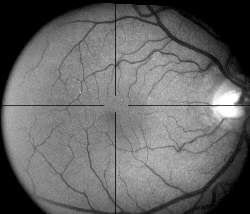|
|
 |
Fundus Imaging Overview
Focusing the Fundus Camera
Excerpt from:
Ophthalmic Photography: Retinal Photography, Angiography, and Electronic Imaging, 2nd Edition
Patrick J. Saine and Marshall E. Tyler
Butterworth-Heinemann Medical; ISBN: 0750673729
Using the Reticle to Focus
View through finder * Single Lens Reflex * Final Photograph
This figure illustrates the relationship between sharpness in the reticle, your fundus view, and the sharpness in the final fundus photograph. When you focus the image without regard to the sharpness of the focusing reticle, you will perceive the fundus image as sharp while the reticle image appears blurry. The image you see is focused by your eyes above the focusing screen, closer than infinity. Even though you see a sharp image in the viewfinder, the exposed photograph will be blurry.
When you view through a correctly adjusted eyepiece before the fundus has been focused on, then the fundus appears blurry while the reticle is distinctly sharp. You have correctly focused on the reticle, however the camera's image has not yet been adjusted to coincide with the receiving plane. If a picture is taken, the resulting image will be as unsharp as you see it in the viewfinder.
After correctly adjusting the eyepiece and the fundus camera's focusing mechanism, both the fundus image and the reticle appear sharp and clear. Your eyes are focused on the reticle, and the image from the fundus camera corresponds with the film plane. Only this final combination will yield a sharply focused fundus photograph.
Setting Your Eyepiece
In order to obtain a sharp view of the reticle, your eyepiece must be correctly set. Here is a step by step procedure for eyepiece adjustment:
Have your eyes corrected for their best visual acuity. You may choose to photograph with or without glasses or contact lenses if your correction is spherical. Remember however, that the correct eyepiece setting will be different depending on whether you do or do not wear your corrective lenses. If you have astigmatism, you should wear your corrective lenses while adjusting the eyepiece. Alternately, correct the eyepiece itself by securing the appropriate trial lens directly over the eyepiece. Do not wear reading glasses. Eliminate any subject matter from the camera's field of view. Set your camera to the farthest focusing extreme and hold or tape a piece of white cardboard in front of the objective lens. When you look through the viewfinder, you should see a blurry reticle on a white field. The illumination level should be adjusted to a medium or low setting (approximately the same intensity as when viewing the retina). If the picture is too bright, it may cause your pupil to constrict, bringing depth of field into play and making an accurate setting difficult. Set the eyepiece adjustment to the maximum plus diopter setting. This will blur any image of the focusing reticle. When looking through the viewfinder, you should
see an evenly illuminated white blur. Relax your eyes. Blink and look at something far away: perhaps down a long hall or at a reflection. It is extremely important that your eyes be focused on infinity
to obtain the correct setting. Keeping both eyes open may help keep you from accommodating. Peer through the viewfinder and begin turning the eyepiece ring towards the zero setting. Smoothly rotate the ring. Rotate at a slow enough rate that you perceive the reticle becoming sharper, but not so slowly that your eyes accommodate for the change. Remember to keep both eyes open and focused at infinity. STOP rotating when the reticle is JUST in sharp focus. If you continue to rotate the reticle after you achieve sharp focus, or if you begin to search for sharpness by rotating the reticle back and forth, then accommodation may be influencing your decision. If your eyes are at their best correction, your setting will probably be within a diopter or so of the zero mark. If your diopter setting is a high minus, chances are that you have accommodated. If you are wearing no correction, the setting should be within a diopter of your best correction. Repeat, Repeat, Repeat. Continue setting the eyepiece until three successive, near-normal settings agree. Note the most consistent position of the eyepiece ring. Remember to correctly set the eyepiece before each patient session. New photographers should repeat this exercise daily until they are confident that their eyepiece setting is accurate. Each fundus camera should be set individually by each photographer. The correct setting for each camera (especially if brands vary) may be slightly different for the same photographer, and the correct setting for a single camera will vary between photographers in the same office. If an instrument has more than one user, a signal can be developed to alert alternate users of possible eyepiece setting changes (perhaps an empty film box placed over the eyepiece). Check the eyepiece setting and reticle before each patient. It cannot be over emphasized that once your personal setting has been ascertained, it is imperative to check it before each patient. Be aware of the focusing screen's reticle throughout each photographic procedure.
Only conscientious use of the eyepiece/reticle focusing system will assure consistently sharp fundus photographs.
|
 |
|




